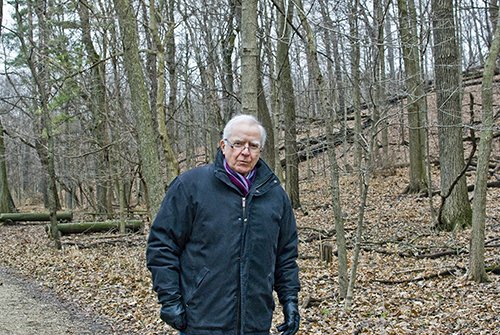
PHOTO BY CLARE HOWARD
William Rau, Illinois State University emeritus professor of sociology, is walking on a trail at Forest Park Nature Center. Rau is studying climate change and fears increasingly frequent heat waves will pose a heightened threat to people living in some of the poorest neighborhoods of Peoria.
William Rau, Illinois State University emeritus professor of sociology, said communities in central Illinois need detailed emergency plans to save human lives based on predictions for more killer heat and humidity.
“Peoria will be more prone to higher death rates –– given its high-humidity, riverine setting and its pockets of high poverty –– than most areas in Central Illinois,” Rau said.
His No. 1 concern is public safety.
“Houses become death traps and isolation can become fatal,” he said. “With a combination of heat and humidity, people in Peoria can become sitting ducks.”
In many urban areas, the elderly poor without air conditioning may be afraid to open their windows due to fear of crime.
“Houses can become 120 degrees. Many houses in poorer neighborhoods have little air circulation, inadequate insulation and no shade. Nearly all heat stroke deaths occur in homes,” Rau said. “In the old days, people planted trees as their air conditioning system.”
Tony Ardis, chief of the Peoria Fire Department, said in extreme heat and cold, the lobby of the Peoria Police Department is open and secure for 24 hours. Fire stations also open their lobbies but only until 10 p.m. If the crew is out on a fire call, people must leave the lobby.
People living outside the area can call and request a welfare check if they’ve been unable to reach a family member or friend in Peoria.
He said relatively few people seek relief from extreme heat and cold at the fire stations. He encourages residents to check on vulnerable people in their neighborhoods.
Rau said cities need to conduct tree canopy surveys and encourage planting drought-tolerant trees rather than trees more vulnerable to severe weather swings.
“Deluges and prolonged droughts will hurt many trees. Sugar maples will not do well. Burr oaks with their deep tap roots will survive droughts,” he said. “We will begin to experience more major flooding and longer heat waves. That means we need to plant trees tolerant of these adverse conditions.”
Tulip trees and sycamore trees are also good choices for handling prolonged drought and heavy rains.
Climate change is a contributor to some of the major wild fires in California but the “negligence” of PG&E energy utility is also a factor, Rau said, adding “We need to create more solar storage, more mini power grids, less centralization, and it’s best to bury power lines. Much of Europe has buried cables.”
Rau is preparing a report for Ecology Action Center in Normal on a plan for municipalities to combat climate change.
In addition to planting more trees, he advocates for major alternations to how municipalities plan parking lots.
Asphalt parking lots will become killing fields as climate change accelerates.
People can survive 90 degrees but people die when the heat index hits 140 degrees to 160 degrees, Rau said. An unshaded asphalt parking lot in central Illinois can reach 160 degrees.
“Asphalt parking lots will become commerce killers,” Rau said. “No one will shop when the lot is 160 degrees.”
Traditional permeable pavers for parking lots cost more than asphalt initially but cost less when maintenance over several decades is calculated. Permeable parking lots also reduce water runoff that creates environmental problems.
Rau is researching a new paver system called the TrueGrid system that is installed on a gravel base and does not cost more upfront than asphalt. This type of surface dramatically reduces the heat given off by parking lots. Another advantage of the TrueGrid system, Rau said, is it creates less compaction so tree roots are able to grow.
“The parking lots of the future will have three essential properties. They will reflect heat, they will be permeable and they will be shaded by a large canopy of trees,” he said.
One solution Rau suggests for watering trees is to direct rainwater from roof tops into large cisterns that can be accessed for trees –– either by gravity or a pump.
Some of the recommendations in his report on changes needed for municipalities include:
- Plant trees at all unshaded bus stops
- Replace more turf grass in city parks and highway medians with deep-rooted prairie grasses and forbs
- Commission a tree canopy analysis
- Phase out gas-powered landscape equipment and replace with equipment run with electric batteries
- Create the position of urban forester
- Consider tax abatements or other incentives for commercial buildings that install green roofs.

1 comment for “ISU Professor: Peoria vulnerable to killer heat waves”
Recent Comments